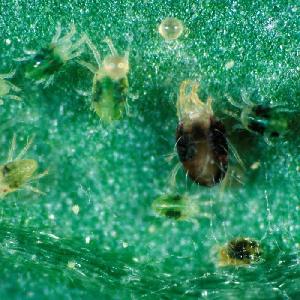 About Red Spider Mite
About Red Spider Mite
Order; Arachnida Family; Tetranychidae
Adult female mites are about 0.5mm long and the males are slightly smaller. The mites are usually yellow or green with darker green markings, although hibernating females turn bright red when they stop feeding in autumn.
The female mites live for a month or more and lay up to 100 eggs each, on the underside of leaves. These eggs hatch after 3-30 days depending on the temperature, and the six-legged larvae pass through two nymphal stages before developing into adults – at 26.5 degrees centigrade, this will take only 8 days.
Breeding is continuous throughout the spring, summer and early autumn when the females stop laying eggs and seek places to hibernate.
How to know if you have Red Spidermites – The Symptoms
The red spider mite (tetranychus urticae) is distantly related to small spiders, which they resemble. They are a common pest and their presence is indicated by a very fine light speckling or as localised pale yellow spots on the upper surfaces of leaves.
Extensive damage is caused to leaves, buds and flowers and leaves will eventually becomes bronzed – in severe cases, leaves may even wither and die.
Examination of the underside of leaves with a magnifying glass should reveal colonies of red mites with minute spherical eggs.
In extreme cases which remain untreated, greenhouses and house plants may be covered by masses of mites and webbing which they spin. Damage may occur at any time of year under glass, and strawberries, peaches, nectarines, cucumbers, tomatoes, cacti, carnations, fuchsias and poinsettias are at risk, although mites will attack almost any plant.
Biological Control & Treatment of Red Spidermite
Accidentally introduced from Chile on a shipment of orchids in 1958, phytoseiulus persimilis is a fast moving predatory mite and the principal biological control for greenhouse red spider mite.
The adult phytoseiulus are slightly larger than the spider mites with longer legs and an orange-red body. They move rapidly over plants, searching for they prey and each individual can consume 5 adults or 20 immature stages of spider mite per day.
The secret of phytoseiulus’ success is simple; it’s development from egg to adult is twice as fast as that of the spider mite at 20-22 degrees centigrade, although the predator does have a problem moving from plant to plant; leaves that touch provide a transfer from one plant to another, and where this is unpractical, the use of string or netting to provide a miniature walkway is advised.
This predator is capable of totally eradicating red spider mite infestations but there is a negative to this positive; the phytoseiulus will die out from starvation and will need to be reintroduced if new spider mite infestations occur.
How to Obtain & Use Spidermite Control
As soon as you realise you have the problem you should apply the predator Phytoseiulus persimilis. Simply apply mites to spidermite infested leaves and leave empty lid or cap on infected plants to allow further predators to escape. Aim to apply 4 mites per sq metre, or 20 per sq m for hotspot treatments
Available in a standard pack of 500 predators or a large pack of 2,000. You can also buy a control programme where you get 2 standard packs delivered over a two week period.
More Information Available from the shop here




put these little buggers under a microscope. Very cool!